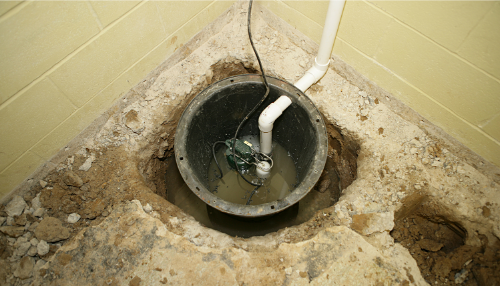May of 2018 was the sixth wettest May on record in the greater DC area with 8+ inches of rain recorded throughout the area. With June keeping up the pace, we have seen more than our share of soggy basements and other rain-related issues. Cleaning up after a water emergency can get quite pricey, and depending on the source of the water (flood from outside vs. flood from inside) your insurance might not cover any of the costs.
In order to avoid the headache, not to mention the financial pain, of a major basement flood, there are a few preventive steps you can take that require minimal effort. So get started now before the next big storm hits:
 Test your sump pump monthly
Test your sump pump monthly
Most basements have a sump pit that collects ground water from around the foundations and then pumps it safely away from the house. Typically they look something like the image below. The pump will have a float on it that turns on as the water rises. If you can reach into the pit, you can lift the float manually to see if the pump kicks on. Otherwise, you can pour water into the pit until it raises the float all the way. If the pump does not kick on then you should have it serviced or replaced immediately.
Check your gutters and downspouts
The easiest way to do this without climbing on a ladder is to grab an umbrella and take a walk around the outside of your home during the next heavy rain fall. If you see water pouring over your gutters that means they are clogged and need to be cleaned. If too much water pours down near the foundation of your home it can cause enough hydraulic pressure to force water to seep into the basement through cracks and seems in your foundation walls.
Check basement stair and window well drains
The drains around the outside of your home typically tie into your sump pit and form a critical part of your home’s defenses against water intrusion. Clogged drains in these areas often lead to water coming in around basement doors and windows. Remember, insurance companies often do not cover water damage coming from outside (as opposed to a pipe burst or failed sump pump), so be sure to keep these drains clear at all times.
Check the grading around your house
Even when all of your home’s flood prevention systems work properly, you can still experience flooding if the grading around your house allows water to flow to and settle at your foundation. Make sure you have proper drainage in your yard to move water away from your foundation. Again, the best time to check on this is during an strong rainfall as it gives you a chance to see for yourself how the water moves around your home (of course do not do this if lightning, high winds or other hazards are present.)
By making these simple activities part of your maintenance routine, you significantly diminish the risk of a catastrophic flood in your home. With weather patterns in the region growing more severe all the time, a little prevention becomes critical.
Click Here to learn more about our monthly Home Maintenance Program




Leave a reply